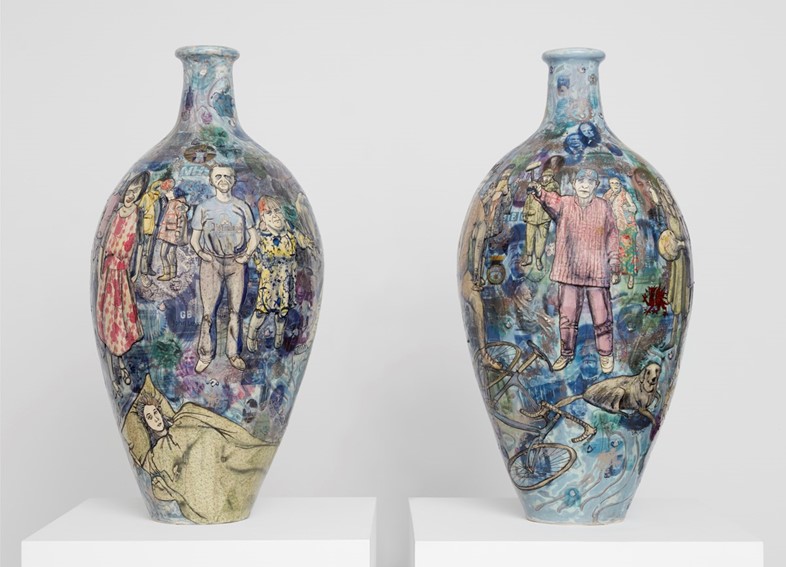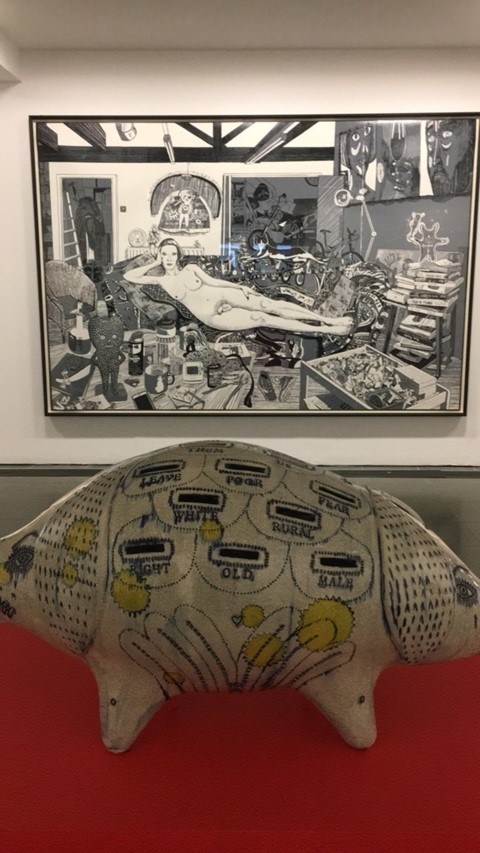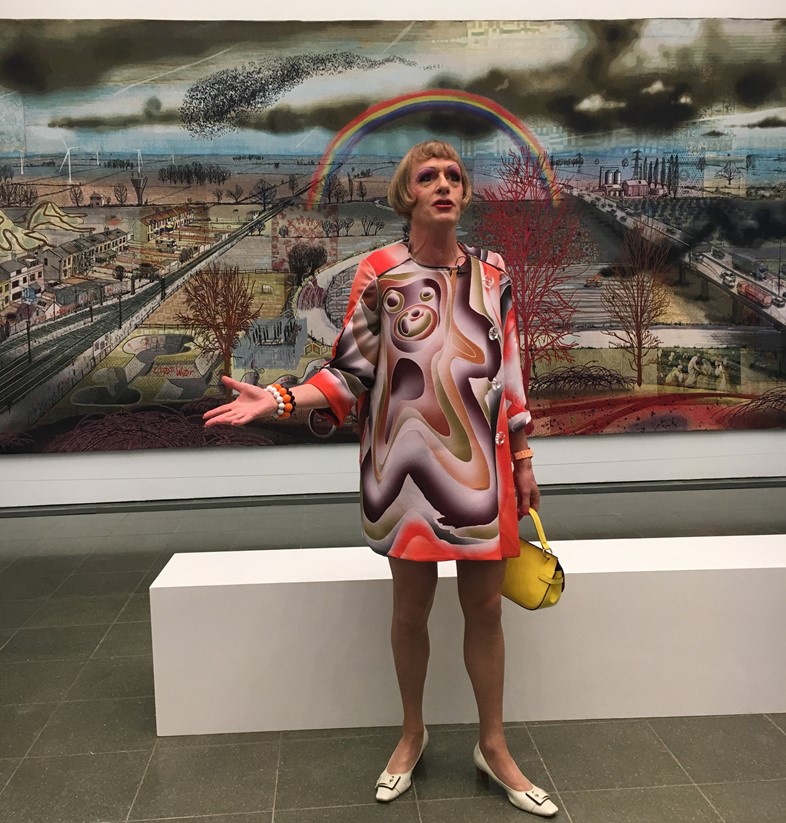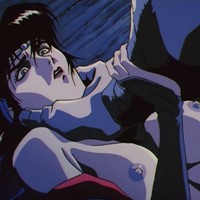The artist and Turner Prize winner holds a funhouse mirror up to Britain and actually makes politics feel palatable – here he shares his thoughts on some of our most pressing issues
It‘s no coincidence that Grayson Perry’s latest exhibition, The Most Popular Art Exhibition Ever!, opens this Thursday – the same date as Britain’s General Election.
Since Theresa May called the GE just six short weeks ago – less than a month after her official spokesperson announced (again) that there wouldn’t be one – our heads have been spinning into overdrive. And they haven’t slowed.
So yes, Thursday marks an important date for these two occasions. And while Perry’s show is nonetheless political, it is inherently more palatable.
Renowned for his social and cultural commentary, Perry holds a funhouse mirror up to our tumultuous climate. So, naturally, there’s a Brexit piggy bank (“Long Pig”, 2017) and a huge tapestry that is 2017’s version of the infamous “Battle of Britain”. The two pots (“Matching Pair”) that were unveiled last week on Channel 4’s documentary Grayson Perry: Divided Britain, whereby the artist took to social media to source images, phrases and ideas from the EU referendum’s Leave and Remain voters – ultimately finding they were more similar than initially imagined – are also present. The politically intolerant will no doubt feel queasy.
Cutting through this discourse is, of course, a giant woodcut work that features a nude Perry reclining in his studio, inclusive of both his genitals and his alterego Claire’s breasts, with his cat Kevin, ready to greet guests entering the show (“Reclining Artist, 2017). Because “I just fancied doing a big nude,” he says. But it’s in “The Fun Room”, as Perry calls it – a place he expects people to end their visit – where things become noticeably less serious. The motorbike (“Kenilworth AM1”, 2010) that he and his teddy bear, Alan Measles, rode on their pilgrimage to Germany is propped up in one corner against a backdrop of Mad King Ludwig’s castle – also where Chitty Chitty Bang Bang was filmed. Adjacent is Claire’s bike (“Princess Freedom Bicycle”, 2017) which is easier to ride in a skirt – and opposite, an ode to his long-standing wife that has been dug up from Perry’s own garden titled “Marriage Shrine” (2017) – reincarnated as a souvenir to be sold in the Serpentine Gallery’s gift shop.
“We’ve all got to learn to talk to people who we don’t necessarily agree with, listen to them and take on board what they have to say. Let it impact on you a little bit” – Grayson Perry
The Most Popular Art Exhibition Ever!, made up of almost entirely new work, is a multi-room curation of woodcuts, installation, ceramics, tapestry, and sculpture work that also touch on issues such as art world popularity and masculinity, alongside British politics. The name itself – The Most Popular Art Exhibition Ever! – is a nod to the two metrics, Perry says, that measure an artist’s success: “One is how much their pieces go for at auction, and the other one is how many people come to their show.”
While some critics have been quick to label the exhibition “too readable, reasonable and obvious” – in the massive governmental grey area that we find ourselves in, the openness of Perry’s art is actually refreshing. Often it’s clear what he’s saying but when he’s not actually saying anything then that’s fine too. Occasionally it’s nice to have a break, to not have to fish out deeper meaning in everything. Especially when most of us (me included) have no fucking clue what’s actually going on with our world.
As Claire showed us around the exhibition ahead of its opening, she/Perry also shared their thoughts on some of the pressing questions that The Most Popular Art Exhibition Ever! asks.

ON HEALING BRITAIN’S DIVISIONS
“We’ve all got to learn to talk to people who we don’t necessarily agree with, listen to them and take on board what they have to say. Let it impact on you a little bit. And not be preaching to them and thinking ‘I’m not gonna let this person persuade me that what they’re saying is right because I’m already got my set beliefs!’ That’s how we develop as human beings. That’s how we form relationships, by allowing other people to impact upon us. Intimacy develops through mutual impact. And so if we listen to people – I mean I talked to a cab driver and I told him “I’m making this programme” (Divided Britain). And we started talking about it and he said ‘This is the first conversation I’ve had about Brexit in ten months without someone losing their temper.’ That’s just one example. We’ve got a lot of heat flying around. We’ve got to learn that there’s no such thing as being totally right or totally wrong. Everybody has to listen and be a little bit impacted by the other person. Yeah maybe it is a bit utopian to say ‘Oh, we’re all in this together, we’ve all got shared identity!’ But often what starts out as a utopian vision, or what you may call political correctness, then becomes common sense! Then it becomes normal. We’ve got to start somewhere.”
ON THE FUTURE OF BRITAIN’S CREATIVE INDUSTRIES
“I was actually teaching at the University of the Arts the day the Brexit result came in and there were a lot of tears, a lot of anger and shock because the university depends on a high number of foreign students, of which many are from the EU. What the reality is in a few years’ time when everything starts to happen I don’t know – education is a massive industry. We’ve got to reframe what it means to work in this country.
Governments have also got to reframe what the nature of the industry is there. The ‘industry’ is now artists, it’s filmmakers, it’s photographers, it’s me, here, it’s television. We’ve got to start framing that as what it means to be industrial in the modern world, in the same way that we now look at smoke stacks from the 19th century as work. Perhaps we should start looking at desktops as the icons of what Industrial Britain is now. It just means we reframe the most traditional, because these are the things that sit in our identity.
I deal with students from all over the world, and it’s very interesting to see the different creative cultures. Every country has its own version of creativity but Britain does seem to have a very particular low impulse control of ‘Let’s see if that works’ kind of attitude to creativity, and it seems to pay big dividends in the creative industry. So let’s see ourselves as having a creatively industrial nature and let’s start taking that seriously.”
“Perhaps we should start looking at desktops as the icons of what Industrial Britain is now” – Grayson Perry
ON USING SOCIAL MEDIA TO MEASURE ATTITUDES
“Social media is interesting, it has a massive effect on our lives, even if we don’t admit to it at the moment. It seems perfectly pitched to act like a collective unconscious and so it’s nibbling away at our attitudes and our opinions all the time. I do follow a lot of ‘Vote Leave’ people out of interest, and I think it’s important after Brexit that we all have a really diverse media theme because I think listening to, talking to lots of different voices and being prepared to be affected (is important). I love having little revelations happen to me! I’m addicted to them and what really got me addicted was having therapy. Therapy can be really challenging, it’s really gonna say ‘Maybe you’ve got to change.’ If someone convinces me that I’m wrong, I go ‘Yeah, maybe you’ve got a point. That’s interesting – I’ve grown.’”
ON AN ART WORLD IN CRISIS
“I don’t think I’ve got a hugely well-informed overview on it. I do sense that either the art world is changing and becoming more globalised or being less materialised. In a way, it’s becoming more politicised and social. (But) I still think there’s a place for significant material culture. We are human beings, we’re still gonna have things in front of us! Our relationship with the material world is still going to happen. I just don’t think it’ll necessarily be the headline issue for art, it’ll become a part of art, one aspect of it.
The demographic shifts that have happened in the art world’s ecosystem that I’ve seen in London is a sort of hollowing out of the middle. I’m very grateful that I’ve had a succession of increasingly more successful art dealers in my career but I think that middle band, where (dealers and galleries) maintain an expensive piece of real estate, they can’t afford it because they’re not selling art at an expensive enough price to maintain that. At the bottom end, you have sort of warehouse artists and brand spaces who (allow artists) to get on a lower rung, but there’s no stepping stone into the Blue Ribbon galleries or the international scene. I think that’s the problem really, and I don’t know how we solve that.”
The Most Popular Art Exhibition Ever! opens Thursday 8 June – 10 September 2017 at London’s Serpentine Gallery











